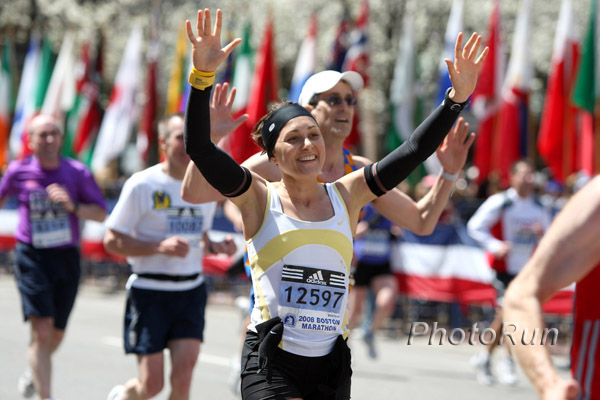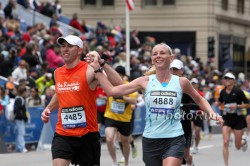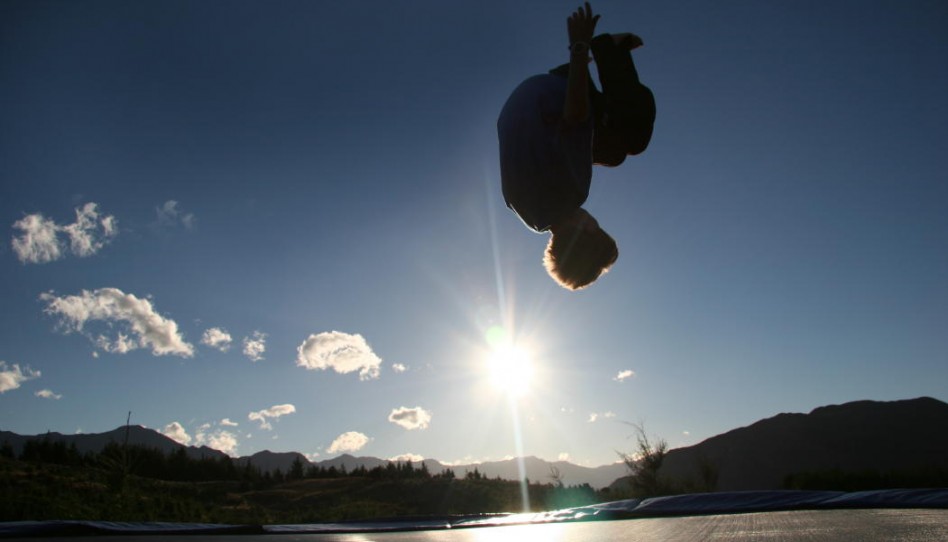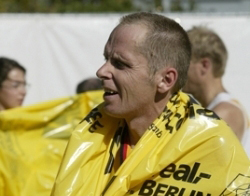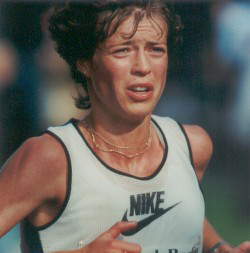Would You Like To Run Better? Relax!
How to Run Relaxed
How to Build A Better Running Body
An On-The-Run Form Check

Maybe you took the ‘Magic Step’ and decided to become a runner. Or you are working out regularly, you are feeling stronger in your stride, and now you might have questions about your running form. Am I moving my arms correctly? Are my shoulders straight and square? You may have asked yourself if there is an ideal running technique and can learning it be helpful in fine-tuning your running style…
The answers to these and related questions are sometimes confusing, despite being debated continuously by coaches, scientists, athletes, and recreational runners. I first discussed this subject on our Website in 2006, but since then I have been fortunate to work with many athletes and recreational runners who have given me valuable additional feedback on this fascinating topic.
During my athletic career I frequently checked and fine-tuned my running technique, making only small adjustments and changes to avoid injury. My primary focus always was to try to run relaxed! It helped me not just to become a better runner but to run as smoothly and as fast as possible. An added benefit was the deep inner relaxation that allowed me to feel a sense of freedom and increased joy while running.
I believe anyone can achieve his or her ideal running technique. Of course, we are all different, not just in height and weight, but also in how we are built—straight shoulders or slanted, long torso or short, bowed legs or not, and so on. Because of the combination of these and other elements, everyone has a slightly different running style. Even among the best runners in the world, you can see a variety of gaits.

Despite this diversity, however, almost all world-class runners have one element of running form in common: they look relaxed! Even when they are clipping along at world-record pace, they appear to be under control, to be running within themselves, with focused but strain-free—almost placid—faces.
I was especially struck by how relaxed top athletes can look while I was training with the Kenyan runners. Many Kenyan friends I have trained with run with an upright but not overly rigid posture—their shoulders are down and relaxed, their arms are held light and low at the side of the body, moving like a fast pendulum in a steady rhythm. Their steps are not too long, and their legs carry the body smoothly, while the arms move in sync with their legs. So elegant to watch! The most striking aspect to me is how they seem to be so relaxed from the inside out, almost like dancing in a fast and pleasant rhythm.
You might be thinking, “Of course they look good—they are Kenyans! What does that have to do with my running form?” But I have come to understand that the beautiful running form so many Kenyan runners have isn’t just something they were born with.
Many of the great Kenyan runners spend a lot of time doing drills and exercises to improve their technique. Even someone as good as Commonwealth Games 5,000m champion Augustine Choge, one of the most successful of their long distance runners, does regular form work, because his coach Brother Colm O’Connell thinks he over-strides, and he is fine-tuning his running technique. Brother Colm has used his diagnostic skills to coach many athletes—including current 800m World Record holder and London’s Olympic champion David Rudisha—to success on the international stage.

Consider the top golf professionals. They practice their swing for endless hours. Although they have excellent mechanical skills, they spend much of their practice focusing on tempo, timing, and smooth delivery—while maintaining proper relaxation. The result is the seemingly effortless and elegant movement you can see when they swing.
Recreational golfers can watch the professionals and apply what they learn to their own game. In the same way, you do not have to be an elite runner to learn how to run relaxed and in a style that is comfortable and unique to you. You can experience the joy of achieving an effective, energy-saving and—most important—relaxed running style, regardless of how far or how fast you are able to run.
You may wonder why there is so much focus on fine-tuning what seems like such a fundamental activity. Improving your technique and staying relaxed while running has many benefits. You can run faster with less effort, you will lower your risk of injury, and you can simply feel better while running. There is plenty of research documenting those first two benefits, but what is less discussed is that final glorious element of simple enjoyment. Achieving deep inner relaxation will help you to become a better runner—whatever your pace—and can give you the sensation of feeling lighter while running, and allow you to move smoothly and almost effortlessly.
How to Run Relaxed
Improving your running form is a long, gradual process. I suggest making small adjustments slowly, step by step. Trying to change too much at once can result in injury. When you concentrate on your running technique, I would not worry about how fast you are running. Try to relax your mind, and let go of any tension you might have built up during the day. It is helpful to run with a free and positive mindset. Tension in your upper body and in your face can often result in a stiffer movement of your arms, shoulders and legs, and you will feel tired more easily. Focus on your surroundings, enjoy the nature around you and the fresh air on your face. Maybe it will help to pick a good weather day to fine-tune your running form.

When I demonstrate relaxed running form to my friends and clients, I try to make it a fun experience. If possible, we go to a special setting like a nice grass track or a beautiful forest trail to create an initial sense of inner relaxation. Then, before I ask them to start running, I study their posture to see if there is anything about the way they carry themselves that could have a strong effect on how they run. I also ask them to visualize themselves running relaxed from within—to be able to feel running as a relaxed movement without pressure and strain.
Finally, before we get started on the real running, I try to help them to conjure up a few more mental images of relaxation like happy dancing… being loose and carefree like a marionette… a cherished personal memory or exciting accomplishment. Try this fun exercise—I hope you will enjoy it.
Only after everyone is relaxed we start paying attention to specific aspects of running form. Some of the elements we focus on are:
- Movement of arms and shoulders: Try not to be too rigid. Arms and shoulders should be relaxed, while the arms function as counterbalance to the movement of the legs to help you to stay balanced while running. As your arms move, allow the shoulders to gently rock with the momentum of your arms. Keep your hands relaxed. Shake them from time to time if you feel tension.
- Center of gravity of the body: Some people run in what looks like a sitting position; others lean forward too much. Try to run upright but not overly rigidly. If you maintain approximately the same upright posture, your center of gravity will not move appreciably, which is the goal. The body’s center of gravity is located in a similar position for everyone: slightly below the navel, approximately even with the top of the pelvis. For more scientific information on running technique, please check Dr. Nicholas Romanov(1).
- Understand how the foot strikes the ground: Your feet land slightly on the outside but mostly on the bottom of your feet, and ideally just forward of your center of gravity. Then they roll in towards the arch as the weight moves to the balls of the feet. Avoid a hard heel strike—this not only slows you down but absorbs the energy you just put into that stride, wasting that energy, and you lose time. In general, shorter, more frequent steps are preferable to fewer, longer strides. If the horizon appears to bob up and down when you run, then you are probably over-striding and have too much vertical motion. See if the horizon becomes more stable if you quicken your cadence and slightly shorten your stride, which means your feet are on the ground for less time, and you run faster. You might want to check the Harvard University research about running barefoot with further explanation on avoiding heel striking(2).
- Use your feet and legs as a unit: Push up with your foot, and use your hamstrings and gluteus (butt) muscles to move your hips forward. When you do this, your center of gravity moves forward. Using your feet in sync with the muscles of your back legs helps you to produce more power, so that you don’t feel as though you are working as hard, and you will be able to run faster. Be conscious of the positioning of your knees. Don’t raise them so high that they are parallel to the ground.
How to Build A Better Running Body
The biomechanical structure of running can be described by the following series of movements: “knee-lift” > “extend leg” > “hit the ground” > “claw back and pull through” > “push-up.”
Each phase of this sequence of running movements can be underdeveloped or overdeveloped within a person’s stride, leading to your not being able to run as fast and efficiently as you are otherwise might be capable of doing. In some cases, one or more of these running movements can be underdeveloped while one or more others simultaneously can be overdeveloped. These differences and the possible conflicts between them can cause significant limitations in a runner achieving his or her potential peak performance.
According to my long-time coach, Dieter Hogen, there are many runners who may have mastered all the normal running phases listed above, but they simply cannot run in a relaxed manner. When compared to world-class runners, they get fatigued prematurely, either because certain muscles are too weak and need to be strengthened, or because their tendons and ligaments are too tight, and need to be elongated.
There are exercises and elements you can add to your training that can help you build a better running body and improve your running form by strengthening and stretching the parts of the body that play key roles in how efficiently you run. And how you strengthen and stretch can determine how close you get to your ultimate potential.
These exercises and elements include:
- Regular fast running: Running fast—and relaxed—once or twice a week can improve your range of motion and can help you run better at all paces. Strides are a great tool to improve your form. After one or more of your easy runs, when your muscles are still warmed up, choose a 60 to 100-meter course. Start the first 15 meters or so easy, then accelerate to 80-85% of your peak running speed for the next segment and stay on this comfortable pace, then accelerate again for the next 15 meters up to 95-100%, and finally decelerate. Repeat this stride 5 times—for stronger runners, up to 10 times—with as much recovery between them as you need to be able to do each with good form. Please avoid any strain. On each stride, you may concentrate on one element of good running form, such as low shoulders or quick turnover.
Many top Kenyan runners include strides weekly throughout the year, often in the form of what are known as ‘diagonals.’ To do diagonals, go to a place such as a soccer field. Run fast from one corner of the field to the opposite corner, and jog along the baseline to the next corner. Then, run fast from that corner across the field to the opposite corner, and jog along the baseline to return to your starting point. (You will have made an X in the field during your fast portions.) Some Kenyan runners replace an easy run with 20 or 25 minutes of diagonals on some days. It is a rather playful and non-strenuous exercise.

- Barefoot running: A few minutes of barefoot running at the end of a run, or a few strides on grass, are wonderful ways of strengthening your foot and calf muscles. It is also nearly impossible to over-stride when you run barefoot, so doing so occasionally can help you to feel what it is like to run with the right stride length. It also can help you to land properly on your feet. And happily, you will get a nice foot massage from running over soft grass and feeling the uneven ground under your feet. So, choose a nice place with grass or sand—free of stones or anything else that could hurt your feet—and have some fun.
- Hills: Doing repeats up a short, relatively steep hill can also improve your range of motion, and can build the leg strength needed to maintain good form when you get tired. Find a hill that takes 30 seconds to one minute to climb at a strong but not all-out running effort. It is best to concentrate on staying upright and driving off of your back leg. Try to run eight to 12 repeats, jogging back down the hill to recover between.
- Drills: Exercises that exaggerate various parts of the running gait can also make you a more graceful runner. After most runs in Kenya, you can see runners doing things like skipping or running along slowly while bringing their heels to their butts or skipping sidewards while moving (skip) one leg over the other (known as grapevines drill). Please find helpful comments by Dr. Nicholas Romanov about this topic, to include drills or not(3).
- Stretching and yoga: Concentrate on your upper body, lower back, hips and legs, especially your quads, hamstring and calves. If you run after a day of sitting at a desk, be sure your shoulders and neck are loose and relaxed, because you have probably had them hunched over for a good part of the day. You might consider trying out special stretching and strengthening exercises from “Yoga for Performancesm,” a program I developed especially for runners. (Please check Yoga for Performancesm: Intro, Part 1, and Part 2.)
- Strength training: By this, I mainly mean exercises that strengthen your core; that is, your stomach, back, butt and hips, where most of your power comes from. Core work such as sit-ups, push-ups and back strengthening exercises will help you to maintain good form for longer, because you will be able to hold yourself correctly even as you tire.
You might find it useful to ask a trainer or one of your fellow runners to give you some feedback and advice about your running technique. First, have them observe you running slow and get them to check each phase of your running technique. Then do the same while running at a higher speed, because now your technique is going to be different. The next step would be to repeat the check-up when your body feels tired, for example, when you are at the end of a hard workout. Use the feedback to analyze your style of running, and see what changes when you move faster.
I often remember a cold winter day training with my first coach. I had been running for about only a year. My coach asked me to run on fresh snow, which just covered the ground of the track we always trained on. I clearly could see my footsteps—my much angled ‘duck like’ footsteps! With the way my feet pointed out, I probably lost half an inch each step. In a marathon, if we add this up, it could be well over two to three minutes that you might lose. On the next loop, I concentrated on keeping my feet straighter as they left their impression on the snowy ground. It worked. It works on a wet trail, too, and provides a friendly reminder you might never forget.
Let’s discuss again that it is best to adjust your form only a little at a time—and accept that not everyone can have perfect running style. Also, I am fortunate that my legs are almost straight, so working on improving the alignment of my feet is okay. If you have strongly bowed legs, for instance, please be extremely careful with even light adjustments to your form, because if you concentrate too much on having your feet point completely forward it might overstress your hips. Always check desired adjustments with a professional—a coach and a sports physician.
Move Forward and Enjoy an On-The-Run Form Check
If you decide to adjust your running technique, it is best to take your time. Choose one area first, discuss your ideas, and visualize them. Then visualize them again in action—while walking, then while running easy, and finally while running faster…
Fine-tune the first change for a while, and later add another element you would like to adjust, then another if necessary. After each adjustment, ask a trainer or fellow runner to check your running style again. This way you make sure you adjust to the new style correctly. If you are on your own, you might check your form in a mirror while running on a treadmill. Or perhaps have a friend bring a camera along and video your workout so you can study your style later.
Even the best runners sometimes relapse into a less relaxed, less efficient form at times. This happened to me quite often at the end of a hard track workout or a race. Because I was feeling tired, I would lose my mental focus, and often my shoulders would go up as you can see in one of the pictures at the beginning of this article. They would get tight and soon I would lose my relaxation in my upper body. During my athletic career I gladly accepted advice from my coach Dieter, who simply yelled at the side of the athletic track, “Shoulders down! Relax!” I could hear his voice and was so thankful. Over the years, I developed a way to react to his advice right away: another deep breath and the shoulders would go down, then I would relax and smile as if to convince myself that I was indeed relaxed. And, you know—it worked.
Please find below an on-the-run checklist of the key elements of relaxed running form. You could run through it in your head during your workouts occasionally to ensure that your form is allowing you to get the most enjoyment out of your training.
- Head: Feel like your head is balanced over your neck, rather than thrust forward or held back. Look 10 meters in front of you. From time to time, check the ground 20 meters to 30 meters ahead of you to make sure you avoid dangerous areas. On easy runs, look left and right and around on occasion—checking out the scenery might help you relax a bit more.
- Shoulders: Keep your shoulders down and relaxed. Also, try not to round your shoulders—keep them straight and square.
- Arms: Keep them low and easy at the side of your body, moving like a fast pendulum in a steady rhythm in sync with your legs.
- Hands: Your wrists should pass by your waist, not your upper chest. Keep your hands cupped in a “relaxed” fist. If you like, place your thumb on your index finger.
- Pelvis: Keep your hips level, and moving straight forward.
- Legs and Feet: Try not to over-stride, and focus on having your legs carrying your body smoothly. Ideally, your feet should touch the ground straight and at the location just forward of your center of gravity.
Finally, try to make sure your whole body is completely relaxed and working as a unit, and that you are focused on keeping your body in an upright posture. This is important in avoiding a lower-back injury by leaning too far forward or backward.
When you experience the wonderful feeling of being relaxed from the inside out, it can make running almost feel like you are “dancing in a fast and pleasant rhythm”—just like the great Kenyan runners I trained with.
I hope this advice can help you run with joy and stay injury free.
Keep Running!

References:
(1) Dr. Nicholas Romanov on running technique: https://posemethod.com/running/, retrieved May 2018.
(2) Harvard University: Lieberman DE, Venkadesan M, Daoud AI, and Werbel WA: Running Barefoot, Forefoot Striking & Training Tips
www.barefootrunning.fas.harvard.edu/index.html, retrieved May 2018.
(3) Dr. Nicholas Romanov: Theory & Practice: To Drill or Not to Drill? www.posemethod.com/to-drill-or-not-to-drill/, retrieved May 2018.
Updated May 6, 2018
Updated September 10, 2012
Updated September 22, 2010
Posted September 20, 2006
- Posted September 10, 2012
© Copyright 2006-2024 by Uta Pippig and Take The Magic Step®. All Rights Reserved.
